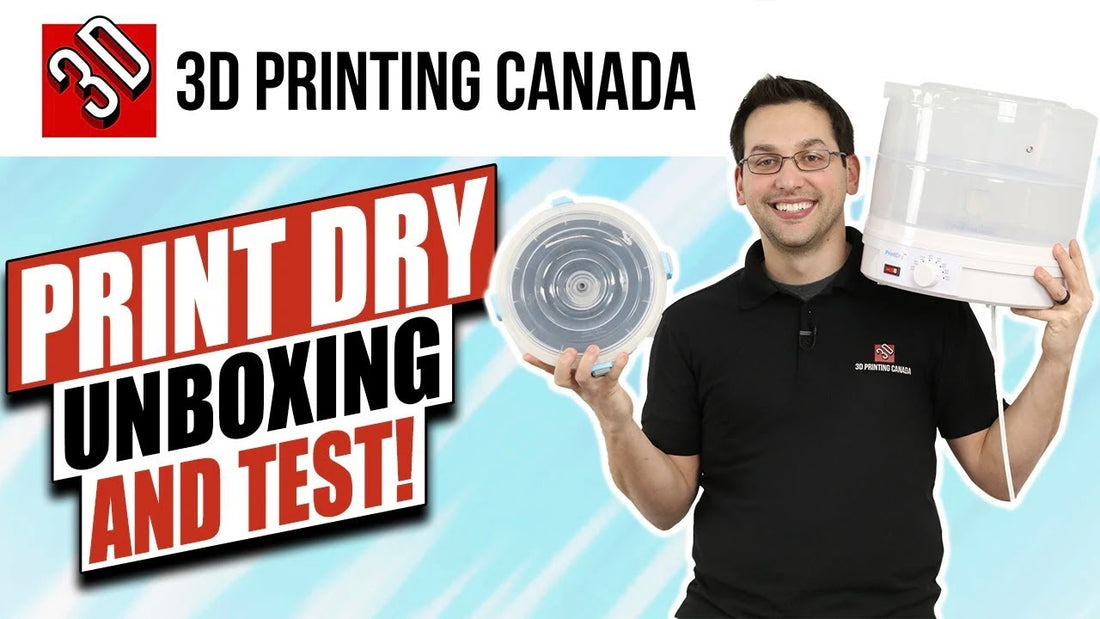Have you ever had nylon or other filament get moisture in it because it was humid? Well now you can dry it yourself at home with a PrintDry.
The PrintDry comes with an optional storage device in which you can seal the filament and suck the moisture out with a pump.
For our test we will be using a roll of Taulman alloy which is 960CF, it’s about 60% carbon fiber, nylon material, and nylon is hydroscopic. A lot of the filaments will absorb moisture to a certain degree. Nylon tends to be one of the worst for that. The spool we are using to test the PrintDry is about a kilo.
The PrintDry is similar to a food dehydrator. It has two specially designed shelves, so you can have two rolls of filament drying at a time. You don’t even have to take the filament out to run it through you machine. It has an eyelet on each level and they will spin freely allowing you to feed it directly into the machine.
There is a guide in the PaintDry manual with instructions on how long different materials take to dry and at which temperature you should dry them. PLA needs a lot less time than something like nylon. For nylon, it needs 12 hours at 70°C, or 160°F.
In order to show you the difference between a wet and a dry print we cut a piece of filament off the spool we are going to dry.
Drying the Filament
Load your first roll of filament into the bottom shelf. In the PrintDry you will see two ball bearing rollers. Lay the spool on top of the rollers. There is a spacer to place the hole of the top of the spool. This will help keep it stable while it spins.

Seal the PrintDry by placing the second layer and the lid on top and locking them in place. Now simply turn it on and set it to the appropriate temperature for your material and wait the appropriate time according to the guide. For our spool it was 70°C for 12 hours. 70°C is max for this unit.
After Drying
Place your PrintDry on whichever side of your printer will allow you to easily feed the filament directly from the unit to your printer. In or example, we place it on the left of our Ender3. You can do it while the unit is still warm.
While the printer is heating up, you can feed the filament through the hole in the plastic ring. Simply turn the unit off, take out the spool, and feed the filament right through the eyelet on its level.
Then put the top back on and lock it in place, finally turn the machine on again to begin feeding out the filament.
Dry Print
Once you’ve fed the dry filament into the printer you can watch the extrusion process. It should be smooth, with no hissing or popping. The layers will adhere nicely during your prints.
Wet Print
During a wet print you can see and hear the effects of the moisture, bubbles, pops, and even steam. There is a visible difference in the finished products of a wet versus dry print. I knew my filament was wet because I was having a difficult time getting the layers to bind together.
With the filament we used, we put out Ender on 245°C, just hot enough to extrude properly.
During the extruding process of the wet filament you can hear it pop and fizz. You will also notice that even after you’re done feeding it, it may continue to ooze out due the expansion of the moisture in the hotend. Another effect you can see are the bumps and bulges in the filament, not the smoothness you would expect of an extrusion.

Storage
The optional storage container is a good way to store your nylon filament, especially if you’re not printing with it for a while. It holds a standard kilo spool.
Place the spool in the container, decide if you want to use some desiccant packs to help keep it dry. You can also use the PrintDry to dry your desiccant packs.
Lock the lid in place and look at the nipple in the center of the lid. If you see a bulge, there is no vacuum to keep the filament dry. Use the hand tool to pump the air out of the container. If you notice over time the bulge returns, simply use the hand tool again.
Now you know how to dry your filament and keep it dry!

